Public transport stations often extend far beyond their utility to become treasured landmarks of the cities they serve. With Serbia currently redeveloping its own rail transport system and the new high-speed link between Belgrade and Novi Sad enticing passengers back to trains, here we hark back to the golden age of trains and urban metro systems by bringing you some of the world’s most stunning stations
The industrial revolution saw trains help to completely transform the world, with the development of these transport networks reaching their peak during the most financially lucrative period, the Gilded Age. With trains having grown in popularity throughout the second half of the 19th century, it should come as no surprise that some of the stations that emerged during that time across Europe and North America represent beautiful architectural works. From inspiring frescoes depicting the heavens adorning high ceilings to shiny floor mosaics, the most eye-catching train stations serve as living testaments to the economic boom brought about by such transport hubs.
Whether they form stops on your daily journey to work or ports of call on international adventures, train stations offer some of the world’s most attractive architecture. From the stunning Gothic Revival style of London’s famous St. Pancras Station to the Art Deco and Spanish Colonial looks of John and Donald Parkinson’s Union Station in Los Angeles, the dramatically designed features of these stations ensuring embarking on a train journey can be an inspiring experience. Which is why you might want to incorporate a trip to one of these famous stations into your itinerary the next time you’re planning a travel adventure.
KANAZAWA STATION
When the old station in the Japanese city of Kanazawa, dating back to around 1898, was upgraded in 2005, it was met with mixed reactions. Many criticised the addition of an ultramodern glass-and-steel dome and giant drum-shaped wooden gate as being out of place. However, visitors continue to flock to this main transport hub of Ishikawa Prefecture, with its modern upgrades and additions contrasting alluringly with the city’s other historical attractions, including its geisha district and former samurai quarters.
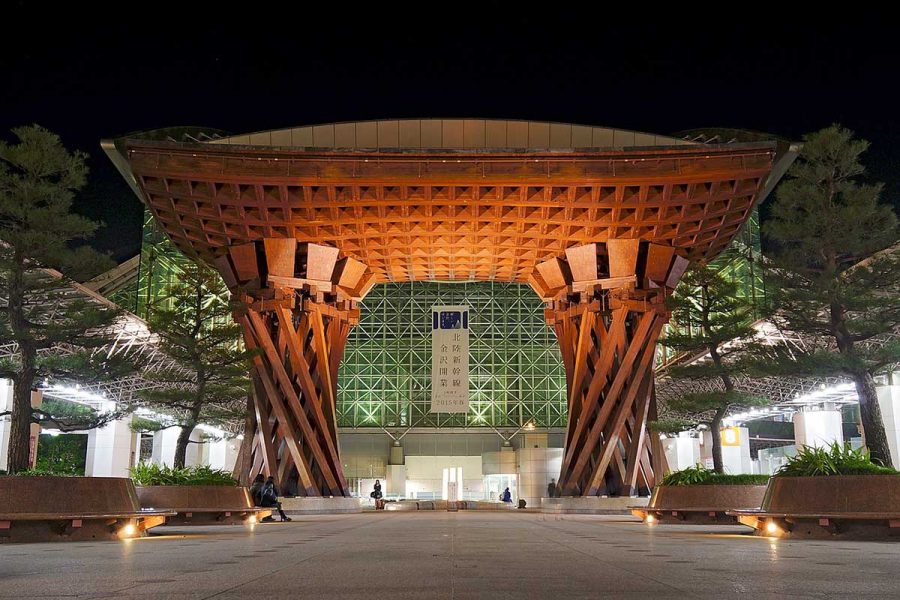
LIÈGE-GUILLEMINS RAILWAY STATION
Renowned Spanish architect Santiago Calatrava opted for steel, glass and white concrete when designing the new railway station for the Belgian city of Liège. Completed in 2009, his new hub replaces the original 1958 International Style station building (itself a replacement for the pre-existing Beaux Arts structure first built in 1842) and intentionally lacks a single façade as a way of bringing together two neighbourhoods that had been previously divided by the railway tracks. The design emphasises Calatrava’s interest in the plasticity of concrete, with his enormous ribbed vault seemingly flowing organically to suggest a wave breaking above the thousands of passengers that pass through the station on a daily basis.

MILANO CENTRALE
Milan’s main railway station, Italy’s second-largest station after Rome’s Stazione Termini, opened back in 1931 and draw design inspiration from Washington, D.C.’s Union Station. However, with Mussolini’s rise to power came the expansion of the existing Beaux Arts design to encompass Art Nouveau and Art Deco elements. The spectacular results include 36,000 square metres of marble flooring adorned with a range of stone sculptures and five train sheds roofed with sprawling iron-and-glass canopies.

HUNGERBURG STATION
British-Iraqi architect Zaha Hadid first made her mark on the Innsbruck region of Austria with the Bergisel ski-jump tower back in 2002, only to return with her design for the Nordpark Cable Railway, a four-station funicular line that replaced a dilapidated tram and now transports passengers along a 1.7km-long vertiginous incline. Hadid’s stations are all topped with lunging glass forms that are reminiscent of ice floes and snowdrifts. The main Hungerburg Station, the final stop in the funicular’s ascent, was completed in 2007.
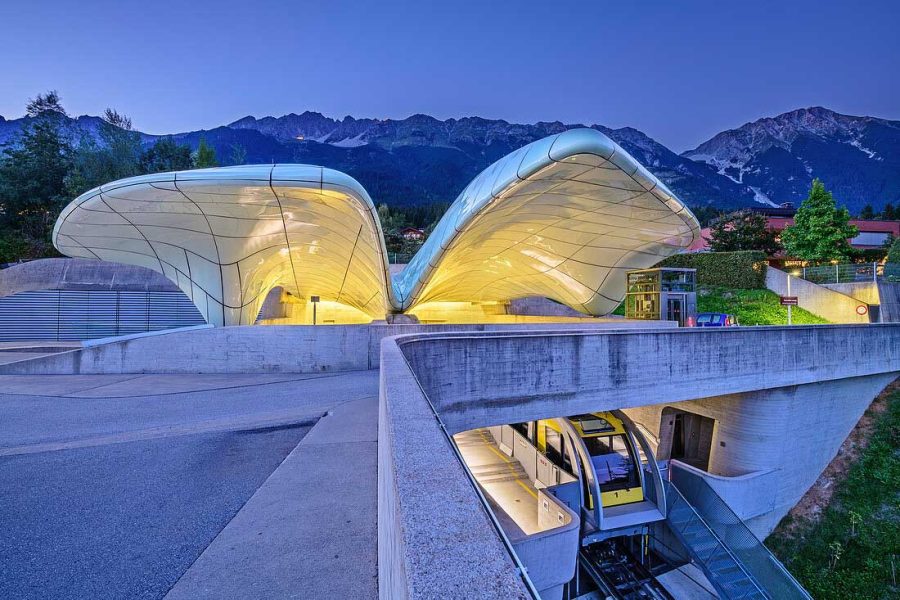
SOUTHERN CROSS STATION, MELBOURNE
Melbourne’s elaborate Southern Cross Station extends the distance of an entire city block and is characterised by an undulating roof held up by a series of Y-shaped columns. Renovated and renamed (it was previously known as Spencer Street Station) in 2005, it now sports an innovative design by London-based firm Grimshaw Architects.

ROTTERDAM CENTRAAL STATION
Like many industrial cities with train stations that have stood the test of time but require upgrading to meet the needs of the modern world, Rotterdam required a new central rail and metro hub to accommodate many more passengers and high-speed and commuter lines. The City chose not to preserve the existing bland 1957 terminal and instead commissioned a team of architectural firms to collaborate on the new complex. Representing the design’s centrepiece is the glittering boomerang-like canopy covering the main entrance hall, as a stainless-steel structure that is brought a degree of warmth thanks to its partial wood cladding. A similar fusion of contrasting cool and warm materials also characterises the platforms, which are under a transparent roof supported by wooden beams. The use of 130,000 solar cells covering the roof area might be less visible but is no less impressive, and it also makes this one of Europe’s largest rooftop solar energy projects.
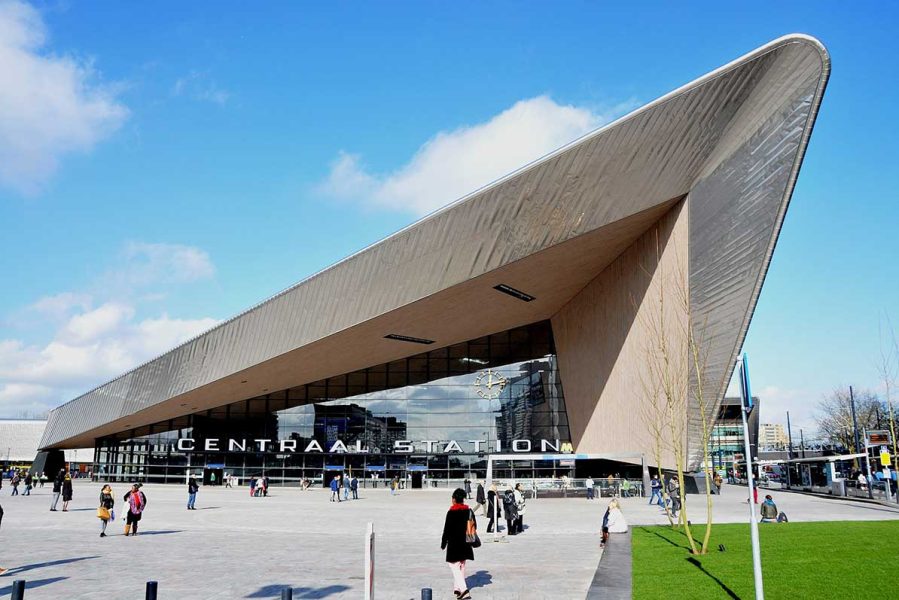
WORLD TRADE CENTER TRANSPORTATION HUB
The terminal station known as the World Trade Center Transportation Hub, located in New York’s Lower Manhattan, became highly anticipated after architect Santiago Calatrava first unveiled his design back in 2004. The project’s centrepiece is the main station house known as the Oculus, a four-billion-dollar glass and steel structure representing the main transport hub connecting 11 subway lines, the PATH train, the Battery Park City Ferry Terminal and several buildings in downtown Manhattan. The main hall is decked white marble floors and culminates with a retractable skylight of over 100 metres. The Oculus is also home to a new shopping centre known as the Westfield World Trade Center Mall.
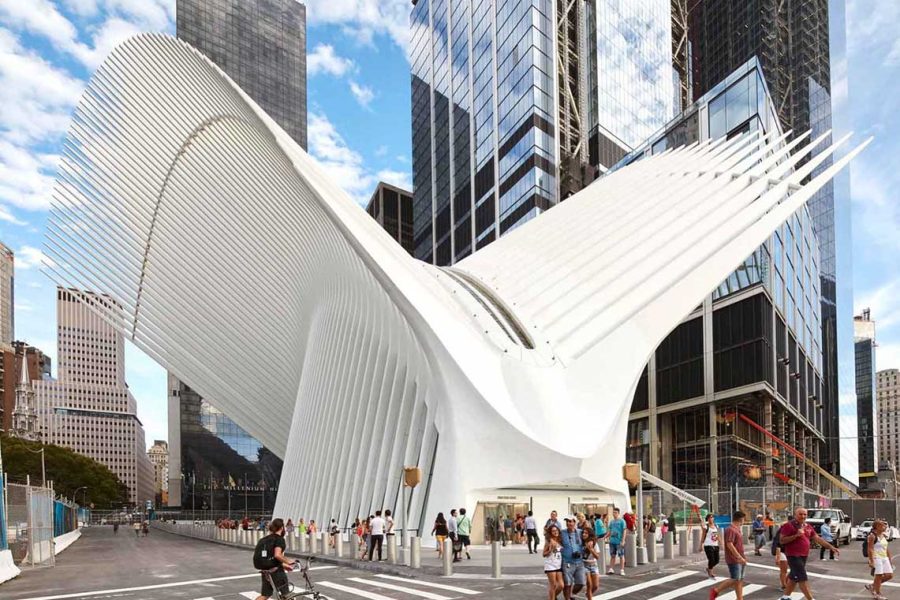
STRASBOURG-VILLE STATION
Strasbourg-Ville station opened in 1841 and was rebuilt about 40 years later. Despite not being in Paris, it remains among France’s busiest hubs of rail transport. The superstructure of this late 19thcentury station was designed by German architect Johann Eduard Jacobsthal, but the building’s most famous section – the Salon de l’Empereur – added in 1900 in honour of then German Emperor Wilhelm II, was the work of another German architect, Hermann Eggert, who also designed the nearby Palais du Rhin. Refurbished between in 2006 and 2007 by French architect Jean-Marie Duthilleul, much of the station’s renovation consisted of restoring the original architects’ work, though Duthilleul did add an iconic glass roof covering the entire historical façade.

ST. PANCRAS INTERNATIONAL
London is home to many great railway stations, but a few of them, like St. Pancras International, represent truly beautiful works of architecture. Originally opened in 1868, at the peak of the Victorian era, this station is considered one of the world’s most elegant. Designed by William Henry Barlow and constructed by the Midland Railway Company, the station is infused with Gothic elements throughout. It served the main line into London from neighbouring cities, and the huge numbers of passengers arriving in the city on a daily basis prompted Midland Railway to construct the Midland Grand Hotel on the station’s façade. It still operates as a hotel today, and is also protected as a Grade I-listed building.
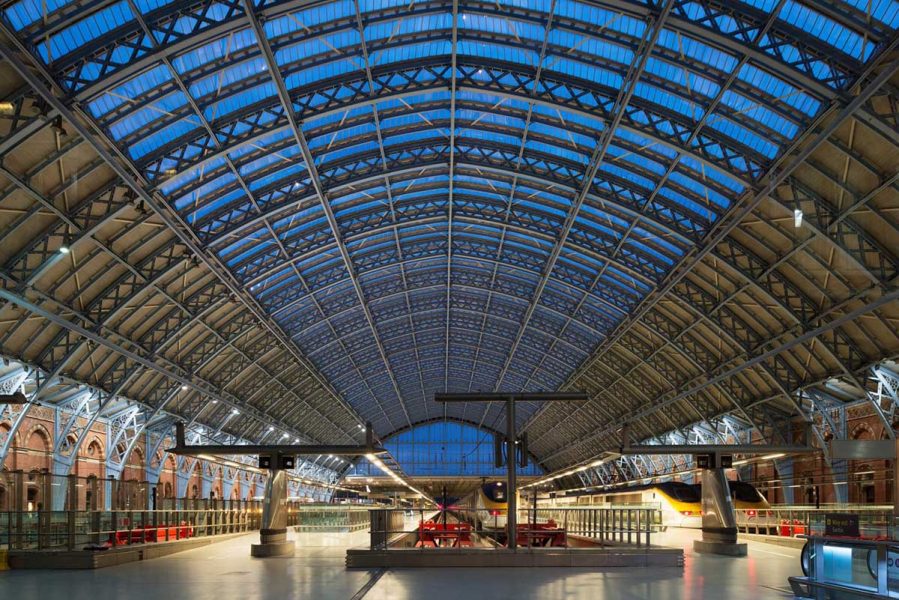
TOLEDO NAPLES METRO STATION
The stations of the Naples Metro underground rail system received a prestigious makeover in the early 2000s, with internationally renowned architects breaking a new look to public transport in this fashionable Italian city. One such metro station, Toledo, was designed by Spanish architect Oscar Tusquets, whose drew inspiration from the simple elements of earth, water and light. The new station was unveiled in 2012 and represents a spectacular work of intricate mosaics.